Leal Science Night Exposes Local Youngsters to STEM, Role Models
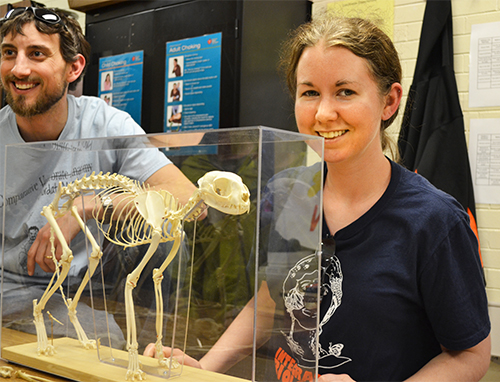
Daniel Urban (left) and Jen Maier, two graduate students from the School of Integrative Biology's Animal Biology Department, encouraged visitors to identify the skelton in the case (it's a cat's) at the "Build a Bone Skeleton Jigsaw" station. Their activity gave students the opportunity to do just that: reassemble pieces of an actual animal skeleton in the right order.
April 13, 2015
Instead of heading to the movies last Friday night, a number of local STEM students and professionals gathered at Urbana’s Leal School to share their passion for their respective fields with local students and their parents at the school’s annual Science Night.
Presenting at the April 10th event were a number University student groups and staff. For example, two undergraduate student outreach groups, Physics Van and Chemistry’s REACT group, shared activities with the visitors. In addition, MechSE undergraduate student Patrick Slade was on hand to demonstrate bionic prosthetics.

Graduate student Daniel Sorensen, from the School of Integrative Biology's Animal Biology Department, showing Science Night visitors several huge dinosaur skulls.
Two graduate student groups also sent a number of students to share their expertise: PBAGS (Plant Biology Association of Graduate Students) and GEEB (Graduates in Ecology and Evolutionary Biology). Members of SACNAS (Society for the Advancement of Chicanos/ Hispanics and Native Americans in the Sciences) also participated.
MechSE’s education coordinator, Joe Muskin, and Xander Hazel from the Orpheum Children’s Science Museum in Champaign, also led students in a hands-on activity making mirrors. In addition, local 4H members provided a station where visitors could make, then “launch” their own stomp rockets. Leal teachers held an egg drop contest; plus the Rube-Goldberg machines the school’s 5th graders made were also exhibited and demonstrated at Science Night.
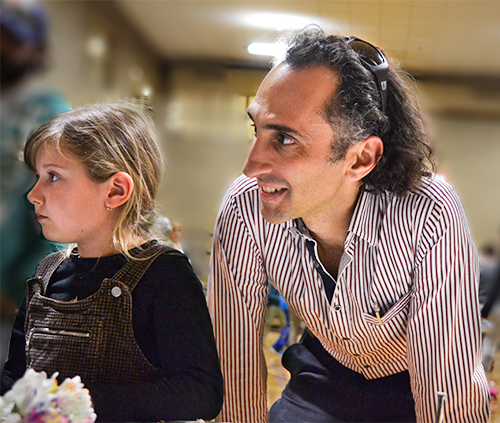
Brian DeMarco (right) and the daughter of one of his Physics colleagues enjoy the magic as one of the Physics Van students does a demonstration.
In his fourth year heading up Leal’s Science Night, Illinois Physics professor Brian DeMarco unashamedly acknowledges that he devotes his time and energy into organizing the event in hopes that it might result in youngsters choosing STEM careers.
“My own mission is to try to recruit as many talented, bright people as we can into this area,” admits DeMarco, “because science research is the most transformational thing we do as human beings…To solve all the challenges we have over the next fifty years, we need as many bright and talented scientists as we can get. So I would like to start solving that problem early.”
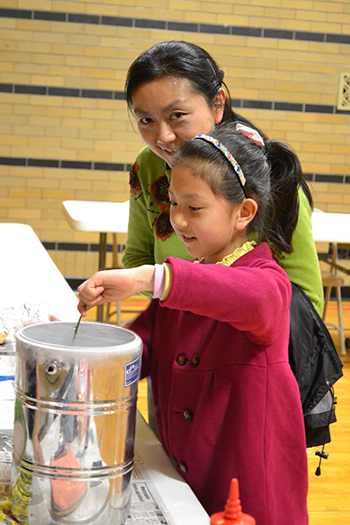
As her mother watches, a 3rd grader dips a blossom into liquid nitrogen at the Physics Van table; the blossom quickly freezes and turns stiff.
By early, he means K–5th grade students—the age of Leal’s student body—including his son, who is in 3rd grade at the school. After citing the need for more workers in STEM-related fields, DeMarco sings the praises of a career in STEM, then enumerates some of the benefits:
“A career in STEM is an amazing opportunity as a career—for anybody. It’s a terrific career:…it’s fun; it’s a great way to stay employed; you can do exciting things; you can get paid well.”
So DeMarco hopes his Science Night will plant a seed—the idea that a STEM career is a viable option—into the heads of Leal students in hopes that it might someday germinate and bear fruit. And according to DeMarco, it’s important to introduce the idea to children at a young age because of the amount of preparation that is needed:
“I think many STEM careers, you actually have to get started early; you have a lot of skills to develop, both technical and programming, and learning about math. So I think that the earlier you get the idea in a child’s head that this is something that they might want to do…the better chance they have of actually making it all the way there.”
DeMarco himself “made it all the way there” in the area of physics. An experimental physicist, he cools gasses of atoms to ultra-cool temperatures (billionths of a degree above absolute zero) then studies what they do and tries to understand why they behave the way they do.
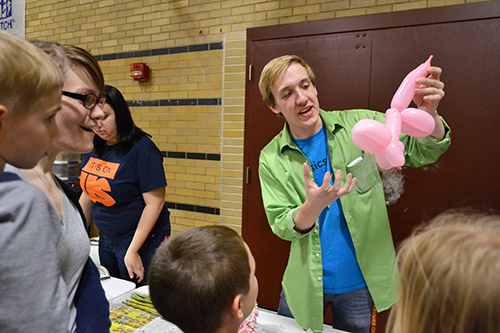
Physics student Robert Snakard awes the crowd at the Physics Van table, demonstrating how the balloon figure has just grown back to its full size after being immersed in liquid nitrogen and shriveled.
He’s also very involved in teaching the next generation. In addition to his outreach at Leal, he teaches students ranging from undergraduate to graduate students, and from non-scientists to future physicists. Given the range, he says his approach or philosophy regarding the way he teaches the various courses is completely different.
For example, in an undergraduate course for non-scientists (Physics 140: “How Things Work”), his goal is to show students why physics is important to everyday things they use—their car, bicycle, phone. One graduate-level course is designed to give students a broad overview of what’s going on in the field while showing them important physics principles.

Taylor Sabatini, Physics Van Coordinator, shoots a cork from a miniature cannon during Leal Science Night.
His philosophy regarding the Leal outreach is to have students—especially undergrads—serve as role models while helping at the event. He figures that if young students see someone close to their age doing science, they might believe that they can do it too.
“One reason I mostly try to have undergraduate student groups come, they [the Leal students] see it’s someone they know is not exactly an adult. I think they see, ‘I could do this too. This is something that I could do,’ when there are “big kids” doing it; that’s the way they think about it: ‘This is something that I could do, and how would I get there?’”
One such undergraduate student group was Physics Van, a student-run organization whose members did fun activities with liquid nitrogen. For example, they shot a cork from a miniature cannon, hammered a nail into a board using a liquid-nitrogen-flash-frozen banana, and demonstrated its effect on gasses, like oxygen, by dipping a balloon animal into liquid nitrogen to make shrivel, then expand when exposed to air temperature. Sophomore Taylor Sabatini, the group’s current coordinator, participated in Science Night. She says she tries to go to as many of the Van’s outreach activities as she can. Her motive for doing outreach is “getting through to young kids. I think it's important to get kids, especially girls, excited about science at a very young age.”

Brian Korn (left) begins to blow on the balloon animal shriveled by the liquid nitrogen to bring it back to room temperature and make the gas inside it expand again.
Sabatini reports that the kids who attended the event “all seemed ecstatic to be there. None of them looked bored, and I loved that. It brings a smile to my face to have kids bouncing around and asking so many questions. I really hope the Science Night sparked an interest for some of the students.”
Helping Sabatini with the demonstrations was Robert Snakard, says he attended, "because I really like showing the kids stuff that they probably won't see until they're bored of science and won't want to watch it. So I'd rather show it to them when they think science is cool. Because a lot of the stuff we show you can't see normally in an elementary school because they don't have the funding for it. "
Another Physics Van member, Brian Korn, an Illinois sophomore in physics, also hoped to get kids interested in science. “By attending Leal science night...I hope to open children's eyes to science who might not otherwise have thought much about it beyond a distanced schoolroom setting.”
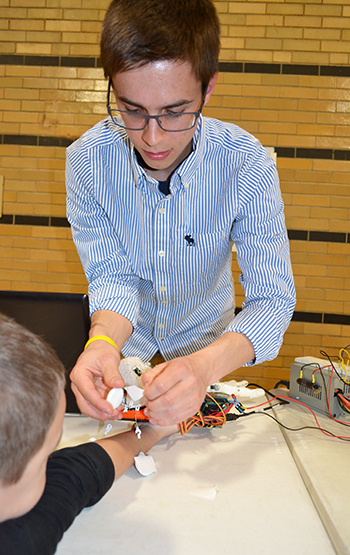
MechSE junior Patrick Slade attaches the sensors of a prostetic hand to a student's arm .
Korn indicates that the reactions of the kids varied with age: “The younger ones were captivated by the seemingly magical happenings before them,” explains Korn, “while the primary school students and older were excited about hearing the how, what, and why behind the liquid nitrogen demos. Even parents were interested to see and hear about the effect liquid nitrogen has on materials. I hope that anyone who was watching and listening walked away with curiosity about the world and not just verbatim facts about liquid nitrogen, since curiosity is what drives discovery.”
Another undergraduate student who participated was Patrick Slade, who demonstrated bionic prosthetics, including one he designed. He attached the prosthesis sensors to the arms of young volunteers so the youngster were able to control the prosthesis using the muscles in their forearms.
A member of Aerospace Associate Professor Tim Bretl’s research group on robotics and neuroscience, Slade, who had also presented at Engineering Open House, appreciated the fact that the Leal event attracted a little younger audience. “Which I think is even better, because I think by middle school, high school, kids already know what they’re interested in, so to show them stuff like this at an even earlier age is great. Get them thinking about it. I know if I saw stuff like this, I would have been like, ‘Wow! I’m gonna’ go build that out of Legos.’ I would have been really interested.”
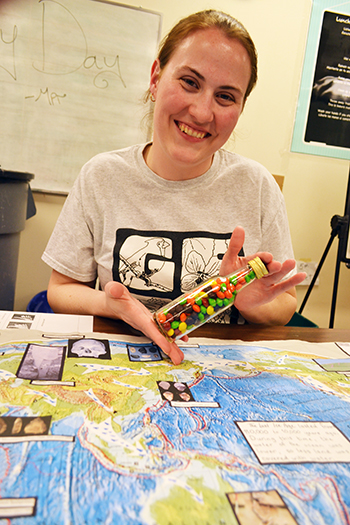
Illinois Ph.D. student Amanda Owings does an activity about human migration at the Science Night.
Although the Illinois graduate students might have seemed a bit less like "kids" to the youngsters who attended the event, they brought their passion for and expertise about their discipline to the table. For example, Amanda Owings, a 3rd year PhD student in the Program in Ecology, Evolution, and Conservation Biology participated in order to share about human migration. Owings, who is studying the effect European colonization had on ancient and living Native American people in Canada, indicates that she also wanted to show kids that science can be fun.
“I enjoy talking about science to young people and helping them learn a little piece of the story about human migration and variation that is not always taught in school. I hope that the students who are interested in science will be able to see the range of the different kinds of science that are out there to study and that science can be fun.”
Regarding the impact the science night had on students, Owings says, "The kids got really excited to learn about new things, but also to tell us the things they already knew."
Helping to staff the SACNAS table was Brenda Andrade, a 2nd year chemistry graduate student who works in Steve Zimmerman’s lab researching innovative strategies for the treatment of heart disease.
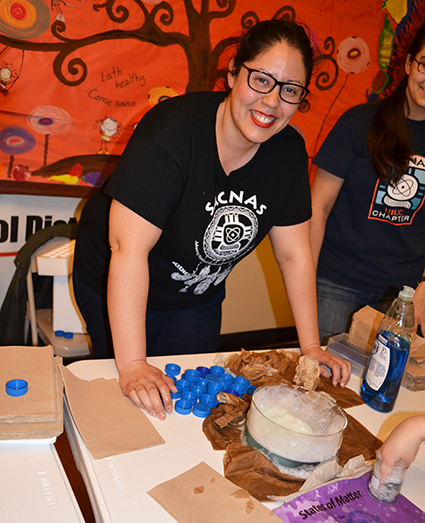
Brenda Andrade, a Chemistry grad student and member of SACNAS, supervizes a hands-on activity during Leal Science Night.
Why would a busy grad student involved in important research take the time to attend a science night targeting younger students? Andrade responds, “Ffirst of all, to foster an excitement for science in all the children that attended the event.”
A 1st generation college student, Andrade is also hopeful that she can personally impact Hispanic youngsters— a traditionally under-served group—and get them interested in STEM by serving as a role model. “I am very interested in taking the opportunity to interact with the children and parents of Spanish-speaking origins,” she admits, “not only share my enthusiasm for science, but to be a role model for these children.”
According to Andrade, the night was a success: “Seeing the children light up with excitement and asking questions, I think sparks a healthy curiosity about how the world works and that it is okay to ask questions,” she reports. “Overall I think it was a great night and I truly enjoyed promoting science to children.”
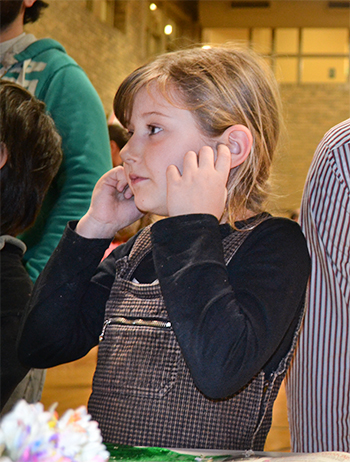
Leal student Simone Aksimentiev prepares in case the next Physics Van demonstration produces a loud noise. (It didn't).
Physics Associate Professor Aleksei Aksimentiev attended Leal Science Night with his two daughters. Surprisingly, though one might expect a physics professor to drag his girls to a STEM event in hopes of coaxing them onto an early trajectory into STEM careers, he insists it wasn't his idea; it was his daughter's:
"Simone asked me to take her and her sister (5 years old) to the science fair. It was her own initiative. I hope she would be interested in STEM but I don’t have an agenda set for her."
Aksimentiev indicates that the night had a positive impact on both: "She absolutely loved the Science Night (and so did her 5-year-old sister)...I guess it solidified the notion that "science is fun."
Story and photographs by Elizabeth Innes, Communications Specialist, I-STEM Education Initiative.
More: Champaign-Urbana Community, K-6 Outreach, Leal Elementary School, STEM Pipeline, 2015
For an aditional related I-STEM articles, see:
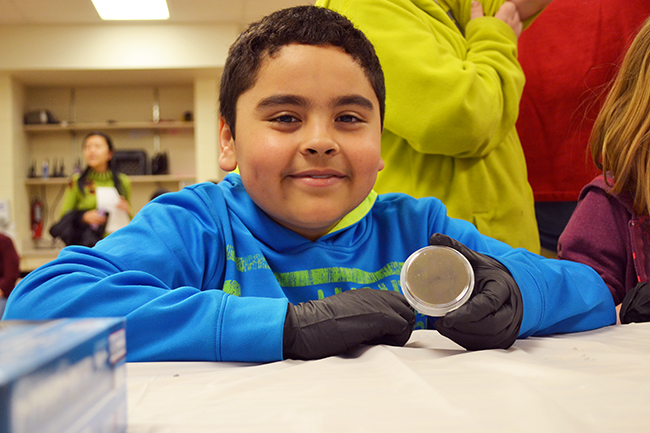
A Leal fourth grader proudly shows off the mirror he made at science night.













.jpg)
















